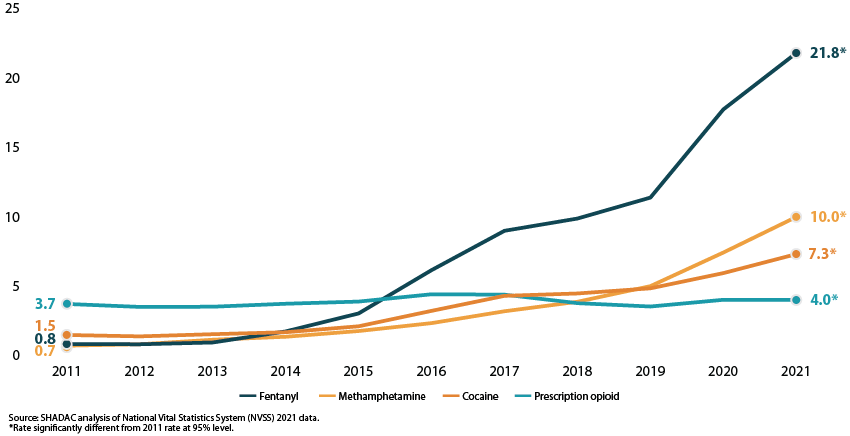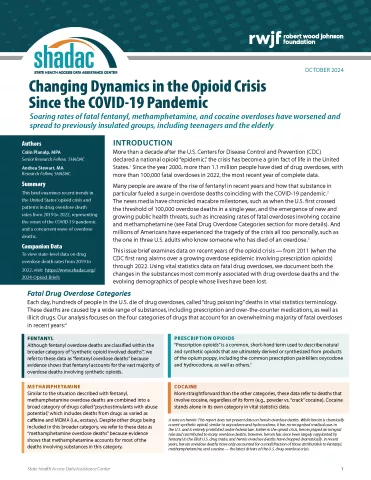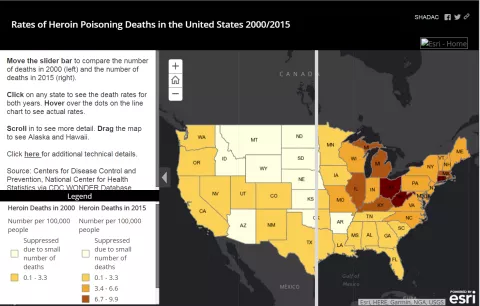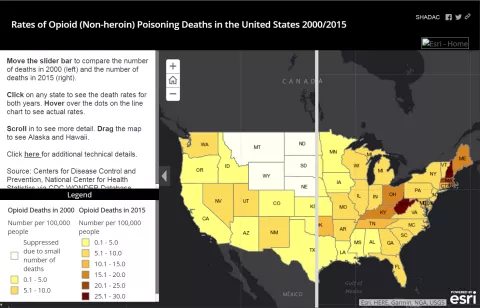The Opioid Epidemic in the United States
Over the past two decades, the United States has experienced a growing crisis of substance abuse and addiction that is illustrated most starkly by the rise in deaths from drug overdoses. Since 2000, the annual number of overdose deaths from any kind of drug in the U.S. has multiplied nearly six times over, rising from 17,500 to over 106,000 people in 2021.1, The vast majority of these deaths (about 80,000) involved some form of opioids, including heroin, prescription painkillers, and, most prevalently in recent years, synthetic opioids such as fentanyl.2 Fentanyl and related synthetic opioids alone accounted for roughly 71,000 drug overdose deaths in 2021, and are also involved in most methamphetamine, cocaine, and prescription opioid overdose deaths—the next most common substances associated with overdose deaths. [3]
For over six years, SHADAC researchers have been tracking trends such as these in the ongoing U.S. opioid crisis. Our goal is to make data available to the public and to state policymakers so that they can be better informed about the unique impacts of the opioid epidemic in their individual state and can better develop tailored solutions to address the issues. Our researchers have developed a number of resources in a variety of formats, including blogs, briefs, infographics, webinars, interactive maps, and even state-level data sets, for researchers interested in exploring the data or conducting further analysis.
History and Background

As noted in SHADAC’s most recent brief, the opioid crisis is widely considered to have its roots in the mid-to late-1990s, when a confluence of factors—including the beginning of the “Pain as the 5th Vital Sign” campaign and the U.S. Food and Drug Administration’s approval of Purdue Pharma’s blockbuster OxyContin—led the U.S. health care system to greatly increase prescribing of opioid painkillers. [4]
For more than a decade, the steadily increasing rate of overdose deaths involving prescription opioids continued with little notice. But that changed around 2011 when the CDC declared deaths from prescription painkillers an “epidemic.” In the years that followed, the U.S. health care and public health systems took steps to rein in prescribing of opioid painkillers. The CDC developed guidelines aimed at reducing risky prescribing patterns, and many states implemented legal restrictions in addition to the voluntary, well-meaning attempts made by many health care providers to be more cautious in prescribing opioid painkillers. The leveling-off of prescription opioid overdose deaths after 2011 suggest some degree of success, though it was limited, and rates never declined in any large or durable way.
Around the same time that prescription opioid deaths peaked, data on drug overdose deaths show that the opioid crisis made a distinct shift. Deaths began to climb first from heroin, an illegal opioid that has been trafficked for decades by criminal enterprises, then from fentanyl and similar synthetic opioids that criminal enterprises also began to traffic. [5],[6]
Heroin rose in popularity as individuals who were addicted to prescription opioids suddenly found themselves cut off from a substance on which they had become chemically dependent and sought out a substitute. Seeking to exploit a growing market for illicitly trafficked opioids, drug traffickers eventually turned instead to fentanyl as it is easier to produce in large quantities than heroin, has a higher potency, and is easier and cheaper to smuggle than its counterpart. Resultantly, death rates from heroin began to recede, while those from fentanyl have only continued to surge.
Decade in Review
In the decade since the U.S. Centers for Disease Control and Prevention (CDC) first declared overdoses from prescription painkillers an “epidemic” in 2011, the opioid overdose crisis has evolved markedly and rapidly from a problem tied mostly to prescription opioid painkillers to one dominated by the meteoric rise of the synthetic opioid fentanyl.

At the national level, data on opioid overdose deaths show multiple, evolving phases of the overdose epidemic. Pre 2011, the growth in opioid overdose deaths was driven primarily by natural and semi-synthetic opioids (i.e., prescription opioid painkillers); but that death rate has since largely plateaued (4.0 per 100,000 people).
Beginning around 2011, deaths from heroin began to increase more rapidly and were responsible for the highest overdose death rates in 2015, before plunging to the lowest rate in 2021 (2.0 per 100,000 people). Since around 2013, deaths from synthetic opioids such as fentanyl have grown precipitously, and in 2021 the overdose death rate from fentanyl alone (21.8 per 100,000 people) was more than double the next highest rate of overdose deaths from another drug type, methamphetamine (10.0 per 100,000 people), quadruple that of heroin overdose deaths (7.3 per 100,000 people), and over seven times the rate of overdose deaths from prescription opioids (4.0 per 100,000 people).
Overall, death rates from all types of opioids have unsurprisingly risen over the past 10 years. Beginning in 2011, the overdose death rate for all opioids was 7.3 per 100,000 people. By 2021, that figure climbed to 24.7 per 100,000 people. Looking at all types of drugs involved with or adjacent to the opioid crisis, including heroin, cocaine, and psychostimulants, overdose death rates have almost tripled during the past decade, growing from 13.2 per 100,000 people in 2011 to 32.4 per 100,000 people in 2021, driven largely by rapid increases over the past two years.
State Trends
Much like the United States as a whole, most of the 50 states have experienced measurable increases in drug and opioid overdose deaths since 2011. Just four states – Hawaii, Oklahoma, South Dakota, and Utah – saw no significant changes in their state rates of opioid overdose deaths.* The states that saw the largest increases in overdose deaths between 2011 and 2021 were California (5.0 per 100,000 people to 17.8 per 100,000 people), Florida (8.4 per 100,000 people to 28.9 per 100,000 people), New York (6.8 per 100,000 people to 24.5 per 100,000 people), Ohio (11.2 per 100,000 people to 40.1 per 100,000 people), and Pennsylvania (6.2 per 100,000 people to 32.8 per 100,000 people). Across the decade, however, West Virginia remained the state with the highest overdose death rates, rising from 31.5 per 100,000 people in 2011 to 77.2 per 100,000 people in 2021.
*Changes in opioid overdose death rates were unable to be calculated for North Dakota, as data are unavailable for that state.
Latest Research
Changing Dynamics in the Opioid Crisis Since the COVID-19 Pandemic

In this new brief from SHADAC, we examine changes in drug overdose death rates, and the types of drugs that cause these fatal overdoses, during the pandemic period (2019-2022). We also look at the history of the opioid epidemic: its beginnings, factors that influenced its evolution, and what it looks like now.
With this brief focusing on the four most common causes of drug overdoses — fentanyl, prescription opioids, methamphetamine, and cocaine — just some of the findings from this pandemic period include:
- Fatal overdoses from fentanyl increased 99%
- Fatal overdoses from methamphetamine increased 108%, and
- Fatal overdoses from cocaine increased 69%
While overdose death rates generally increased across all the measured racial and ethnic groups, “we […] found evidence of dramatic and growing disparities across racial and ethnic groups in rates of fatal overdoses, with the crisis increasingly harming American Indian and Alaska Native people and Black people during the pandemic era,” lead author and Senior Researcher Colin Planalp says.
In this brief, we explore these findings and more, including looking deeper at the impacts of the opioid crisis on different communities, demographics, and states. Click here to read the brief in full. The appendix for this piece is available here.
Additional Resources from SHADAC
Blogs
- During the Pandemic, Drug Overdoses Became the Third Leading Cause of Death for U.S. Adolescents
- UMN Opioid Advisory Task Force
- Charting two decades of the evolving opioid crisis
- 2020 U.S. alcohol-involved deaths climbed by 26.6%, and drug overdose deaths by 30.6%
- Drug overdose deaths grew by almost 30 percent in 2020
- Pandemic drinking may exacerbate upward-trending alcohol deaths
- After drop in 2018, newer data indicate a resurgence in drug overdose deaths
- 50-State Infographics Provide an Updated Overview of the Evolving Opioid Crisis
- Minnesota's Growing and Evolving Opioid Crisis
- National and State Trends in Opioid-Related Overdose Deaths from 2000 to 2017 (Briefs)
- SHADAC Researcher Colin Planalp Talks Trends in the Opioid Crisis with the University of Minnesota
- SHADAC Releases 50-State Analysis of the Evolving Opioid Crisis (Infographics)
- New Data on Drug Overdose Deaths Highlight the Need for State-Level Analysis
- The Changing Opioid Epidemic: State Trends, 2000-2016
- The Changing Opioid Epidemic: National Trends, 2000-2016
- The Opioid Epidemic: State Trends, 2000-2015
- The Opioid Epidemic: Exploring the Data on Overdose Deaths Nationwide from 2000 to 2015
- SHADAC Research in AJPH: Addressing Opioid Addiction through Cross-Sector Collaboration
- State Health Compare Updated to Include 2017 Opioid-Related Overdose Data and New Data on Overdose Deaths from Other Drugs
- Prescription Opioid Sales Data Added to State Health Compare
Briefs
Opioid and Related Drug Overdose Deaths
SHADAC has historically produced annual briefs that provide high-level information about opioids and opioid addiction present the historical context for the epidemic of opioid-related addiction and mortality in the United States, and examine trends in opioid-related mortality across the country and among population subgroups as well as among the states.
The Opioid Crisis in the Pandemic Era Brief
The Opioid Epidemic: National and State Trends in Opioid-Related Overdose Deaths, 2000-2016 (Briefs)
Opioid Use Prevention and Intervention Briefs
Strategies to Increase Access to Medications for Opioid Use Disorder during the COVID-19 Pandemic and Beyond
SHADAC researchers Carrie Au-Yeung and Lynn Blewett, along with Hennepin Healthcare researcher Tyler Winkelman, authored a Milbank Foundation policy brief that examines the federal and state policies changes put in place to improve access to medications for opioid use disorder (MOUD) during the COVID-19 pandemic, during which time MOUD became especially challenging to access because MOUD patients are typically required to have as many as six in-person clinic visits a week.
Issue Brief Examines Ohio Strategy to Improve Opioid Prescribing Through Payment Reform
A collaborative issue brief between SHADAC and the Center for Health Care Strategies (CHCS) with support from the Center for Medicare & Medicaid Innovation (CMMI). SHADAC Senior Research Fellow Colin Planalp profiled the innovative work in Ohio to link the state’s payment and delivery system reforms with another important policy priority: interventions to curtail the opioid crisis.
Infographics
Alongside the 2017 and 2018 editions of our opioid overdose briefs, SHADAC produced a series of two-page infographics for each of the 50 states, as well as the U.S., that highlight key findings for trends in drug overdose deaths. Using the latest available data from SHADAC's State Health Compare, the two-page profiles examine state-level variations in opioid overdose deaths by opioid drug type, as well as by two types of non-opioid illicit drugs that are commonly involved in opioid overdoses: cocaine and psychostimulants. The infographics also show how each state's overdose rates compare to the national average and provide a high-level comparison of all 50 states' overdose rates broken down by each drug type.
Overdose Crisis in Transition: Changing Trends in a Widening Drug Death Epidemic
A webinar hosted by SHADAC on November 24, 2020, focused on analyzing and discussing changes in overdose deaths in more recent years, especially in 2018. Using the latest available data, Senior Research Fellow Colin Planalp detailed changing trends—both in terms of substances and subpopulations of concern—across the nation and among the states.
A webinar hosted by SHADAC on September 4, 2019, examined the U.S. opioid epidemic through national and state-level data on drug overdose deaths, including opioids such as prescription painkillers, heroin, and synthetic opioids, and non-opioids (but related drugs) such as cocaine and psychostimulants (e.g., methamphetamine). Senior Research Fellow Colin Planalp detailed changing trends in the opioid crisis and how the specifics vary across states—both in the scale of the epidemic and differences in the top substances of concern. Research Fellow Robert Hest also demonstrated how users could access and utilize the data on overdose deaths available on State Health Compare, which are drawn from the U.S. Centers for Disease Control and Prevention (CDC) and the U.S. Drug Enforcement Administration (DEA).
Exploring the New State-Level Opioid Data on SHADAC's State Health Compare (Webinar)
A webinar hosted by SHADAC on September 5, 2018, explored opioid data at the state level between 2000 and 2016. Senior Research Fellow Colin Planalp discussed trends in overdose deaths by drug type (heroin, prescription painkillers, etc.) and, using data from State Health Compare, also looked at which states have the highest rates of opioid-related deaths and which states have experienced the largest increases in overdose death rates. Research Fellow Robert Hest also demonstrated how users could access and utilize the data on overdose deaths available on State Health Compare, which are drawn from the U.S. Centers for Disease Control and Prevention (CDC) and the U.S. Drug Enforcement Administration (DEA).
Interactive Maps
For the 50-state analysis on drug overdoses we produced in 2019, SHADAC also created a map that houses a two-page overview on overdose data overall and by drug type for each state, allowing readers to see where each state ranks in number of overdose deaths. Click on a state below to see each state's infographics.
Opioid and Non-Opioid Illicit Drug Overdose Rates for all 50 States, 2000-2018
For the two national and state-level opioid trend briefs we produced in 2016, SHADAC also created two slider maps featuring heroin-related and non-heroin opioid-related overdose deaths from 2000 to 2015.
| Heroin-Related Overdose Deaths, 2000-2015 | Non-heroin Opioid-Related Overdose Deaths, 2000-2015 |
|---|---|
Image

| Image

|
Opioid Data - State Health Compare
Opioid Data - State Health Compare
Data Measures
Sales of Opioid Painkillers
This measure includes data on sales of the prescription opioid painkillers oxycodone and hydrocodone. Prescription sales data are available for each state and the nation from 2000 through 2021 and are measured in annual kilograms of oxycodone and hydrocodone sold per 100,000 people. Data comes from the U.S. Drug Enforcement Agency's (DEA) Automated Reports and Consolidated Ordering System (ARCOS) Retail Drug Summary Reports.
Opioid-Related and Other Drug Poisoning Deaths
This measure includes data on opioid-related and other drug poisoning (overdose) deaths broken down by five drug types: Natural and semi-synthetic opioids, synthetic opioids, heroin, cocaine, and psychostimulants. Data comes from the U.S. Centers for Disease Control and Prevention, National Center for Health Statistics via the CDC WONDER Database, and estimates are available for each state and the nation from 2000 through 2021.
SHADAC Opioid Research in the Media
- CVS and Walgreens to pay a combined $10.7 billion settlement for alleged opioid prescription lapses NBC News (December 12, 2022)
- Spotlight in Focus: Opioid Crisis Demands Psychedelic Innovation, Yesterday Psychedelic Spotlight (March 4, 2022)
- Newest phase in opioid epidemic: Mix of opioids and stimulants like coke and meth Minnesota Reformer (January 21, 2020)
- Expanding Medicaid programs helped - but didn't solve - the opioid crisis Healthline (January 14, 2020)
- St. Paul experiences overdose spike over past few weeks The Center Square (January 7, 2020)
- Cocaine overdoses rise as fentanyl is mixed in Omaha World-Herald (December 30, 2019)
- Not yesterday's cocaine: Death toll rising from tainted drug The Louisiana Weekly (December 2, 2019)
- The Drug in the Shadows Minnesota Alumni Magazine (December 1, 2019)
- Not yesterday's cocaine: Death toll rising from tainted drug Taunton Daily Gazette (November 29, 2019)
- Not yesterday's cocaine: Death toll rising from tainted drug Kaiser Health News (November 27, 2019)
- Ohio leads U.S. in cocaine deaths The Crime Report (November 26, 2019)
- Cincinnati and Ohio at epicenter of spiking fatal ODs from fenanyl-laced cocaine Cincinnati Enquirer (November 26, 2019)
- Tainted drugs: Alarming surge in cocaine deaths is US - as drug is cut with deadly opioid The Sun (November 20, 2019)
- Death toll from tainted cocaine rising across the country NBC News (November 17, 2019)
- The Real Cost of the Opioid Epidemic SNO (November 4, 2019)
- Grand Marais clinic offers opioid treatment Duluth News Tribune (July 31, 2019)
- Numbers suggest progress on opioid fight MPR News (July 9, 2019)
- Talking opioid crisis trends with UMN St. Peter Herald (April 15, 2019)
- Opioid epidemic a painful reality in U.S. Morrison County Record (April 7, 2019)
- In crisis: What are opioids, really? Kanabec County Times (April 4, 2019)
- Talking opioid crisis trends with UMN UMN News (March 21, 2019)
- Overshadowed By Opioid Epidemic, Lack of Resources Hurts Pittsburghers Addicted to Meth WESA Blog (February 13, 2019)
- Study: Rising concerns that synthetic opioids contaminate other drugs, too MPR News (February 13, 2019)
- Prescription Opioid Sales in New York from 2000 to 2017 Patch (November 28, 2018)
- Infographic: Which States Have the Highest Rates of Opioid-Related Insurance Claims Filter (October 15, 2018)
[1] National Center for Health Statistics (NCHS). (2022, May 11). U.S. Overdose Deaths In 2021 Increased Half as Much as in 2020 – But Are Still Up 15%. Centers for Disease Control and Prevention (CDC). https://www.cdc.gov/nchs/pressroom/nchs_press_releases/2022/202205.htm
[2] Spencer, M.R., Miniño, A.M., & Warner, M. (2022, December 1). Drug Overdose Deaths in the United States, 2001–2021. NCHS Data Brief (No. 457). https://www.cdc.gov/nchs/data/databriefs/db457.pdf
[3] Spencer, M.R., Warner, M., Cisewski, J.A., Miniño, A., Dodds, D., Perera, J., & Ahmad, F.B. (May 2023). Estimates of Drug Overdose Deaths Involving Fentanyl, Methamphetamine, Cocaine, Heroin, and Oxycodone: United States, 2021 (NVSS Rapid Release Report No.27). National Center for Health Statistics (NCHS). https://www.cdc.gov/nchs/data/vsrr/vsrr027.pdf
[4] Planalp. C., Hest, R., & Lahr, M. (June 2019). The Opioid Epidemic: National Trends in Opioid-Related Overdose Deaths from 2000 to 2017. State Health Access Data Assistance Center (SHADAC). https://www.shadac.org/sites/default/files/publications/2019%20NATIONAL%20 opioid%20brief%20FINAL%20VERSION.pdf
[5] Planalp. C., Hest, R. (August 2020). Overdose Crisis in Transition: Changing National Trends in a Widening Drug Death Epidemic. State Health Access Data Assistance Center (SHADAC). https://www.shadac.org/sites/default/files/publications/2020%20NATIONAL_SHADAC_Opioidbrief.pdf
[6] Ahmad, F.B., Cisewski, J.A., Rossen, L.M., & Sutton, P. (2023, August 16). Provisional drug overdose death counts [Data set]. National Center for Health Statistics (NCHS). https://www.cdc.gov/nchs/nvss/vsrr/drug-overdose-data.htm
